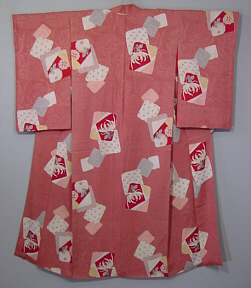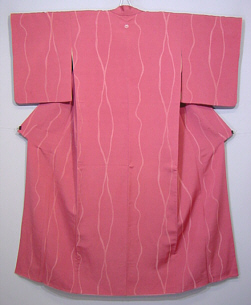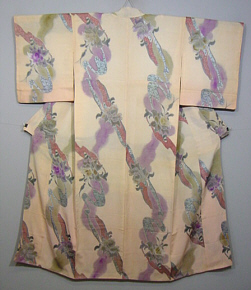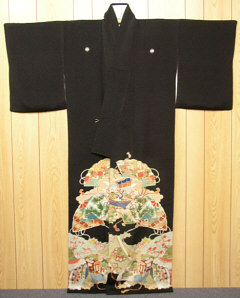|
All
Kinds of Kimono
You
mean there's more than one? Oy...
Well yes there is more than one type of basic Kimono all
the way through to the most elaborate and formal.
Assorted
Not only are there a
number of types of kimono, they also come in a wide
variety of color and pattern. So many choices! See a few
variations below.
Yukata
The Yukata is a casual light cotton kimono for
wearing in summer. Yukatas normally have very brightly colored
designs on them. Today these kimonos are mainly worn to
the traditional Bon-Odori and summer festivals. The
relative simply design of Yukata means Japanese women
can, with some practice, put this kimono on unassisted.
The name yukata comes from the word ‘yu’ (bath)
and ‘katabira’ (under clothing). In the Heian era
(794-1185), court nobles wore linen ‘yukata’ which
were draped loosely after taking a bath. The yukata was
later also worn by Japanese warriors and by the Edo era
(1600-1868), it was widely worn by the public when
public bath became a popular recreation in Japan.
Tsukesage
The name tsukesage comes from the way in which the
designs are applied to the kimono. Starting at the
hemline in the front and back the patterns move upward,
meeting at the top of the shoulders. Tsukesage may be
worn at either formal or semi-formal gatherings.

Iromuji
Iromuji means that the kimono is colored, but has no
dyed patterns except a single-family crest placed at the
back. . The materials for iromuji are figured satin (mon
rinzu) or crepe (chirijmen).

Homongi
Homon means "visit" and gi means, "
wear." This is a formal kimono worn by both single
or married woman on special occasions. It is a
simplified version of the furisode and tomesode. Designs
for homongi are very decorative and the patterns run
continuously over the seams. Sleeve length varies
between 22 inches and 28 inches. This kimono is usually
worn with fukuro obi with a matching obi-age and obi-jime.

Tomesode
 Kuro-tomesode Kuro-tomesode
The most formal kimono for a married woman is the
five-crested kuro (black) tomesode. It is
worn on formal occasions such as weddings and other
ceremonious occasions. In comparison to the long
"waving" sleeves of the furisode, tomesode
sleeves are shorter. Elaborate designs are applied only
to the lower half of the kimono. This kimono creates an
impressive and striking black and white contrast. The
white under-kimono, made of haubuae silk or rinzu
(silk crepe), whose collar sharply defines the lines of
the kimono, further heightens the elegance of this
kimono.
Iro-tomesode
Married women may wear colored tomesode with dyed
or sewn family crests on formal occasions. Although the
colors and designs give it a lighter and more festive
air, the iro (colored) tomesode ranks next
to the black tomesode among formal kimono.
Both kuro-tomesode and iro-tomesode have
the family crest (kamon) dyed or embroidered in either
one at the back, or one on each side of the front and
three cross the back.
For both kuro-tomesode and iro-tomesode,
the double-folded obi (furkuro obi) woven with
gold or silver thread is worn along with the obi-age
made of dappled white tie-dye (kanoko). The obi-jime
may be either a white, round, blind-stitched silk cord
or gold or silver braided silk cord. The sandals (zori)
should be either gold or silver.
Furisode
Furisodoe is the most formal kimono for unmarried
women. Furisode means "long flowing sleeves" .
Sleeve length varies from full length to short. They
usually have rich decorative designs using elaborate
techniques of hand painting or embroidering. Most women
attend Coming-of-Age-Day ceremony in colorful Furisode.
The sumptuous furisode especially worn by a bride under
uchikake is called kakeshita. Kakeshita is usually
longer than usual kimono, so it may be perfect for women
of taller size. Furisode can be used either as a lovely
garment or an interior decor.
Uchikake
Uchikake is an ornate wedding coat with a long trail,
which brides wear during the wedding ceremony. It is
worn like a robe without obi over another kimono, called
kakeshita, which is tied with obi. Uchikake is usually
heavily brocaded or embroidered with the motif of
congratulations such as cranes, pines, flowing water and
a bounty of flowers. The bottom of Uchikake is padded to
trail along the floor.
| 
